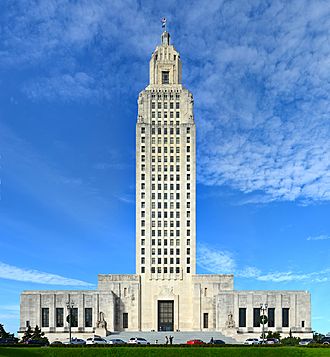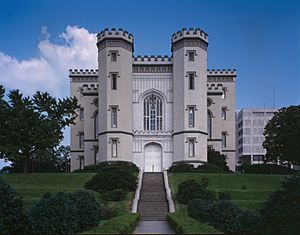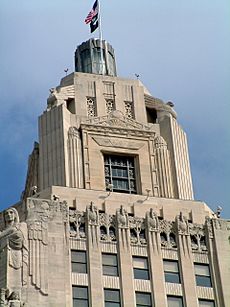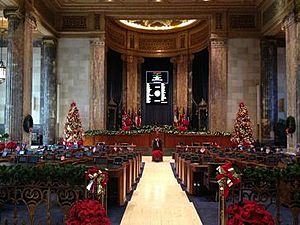Louisiana State Capitol facts for kids
Quick facts for kids Louisiana State Capitol |
|
|---|---|
 |
|
| General information | |
| Architectural style | Art Deco |
| Location | 900 North 3rd Street Baton Rouge, Louisiana United States |
| Coordinates | 30°27′25″N 91°11′14″W / 30.45704°N 91.18736°W |
| Construction started | December 16, 1930 |
| Inaugurated | May 16, 1932 |
| Cost | $5 million |
| Client | State of Louisiana |
| Owner | State of Louisiana |
| Height | 450 ft (137 m) |
| Design and construction | |
| Architect | Weiss, Dreyfous and Seiferth |
| Official name: Louisiana State Capitol Building and Gardens |
|
| Designated: | June 9, 1978 |
| Reference #: | 78001421 |
| Designated: | December 12, 1982 |
The Louisiana State Capitol is the main building where Louisiana's government works. It is located in downtown Baton Rouge. This tall building holds the rooms for the Louisiana State Legislature. This includes the House of Representatives and the Senate. It also has the office for the Governor of Louisiana.
The Capitol is 450 feet (137 m) tall and has 34 stories. It is the tallest building in Baton Rouge. It is also the tallest state capitol building in the entire United States. The building sits on a 27-acre (110,000 m2) area. This area includes beautiful gardens. Many people call it "Huey Long's monument." This is because former Governor and U.S. Senator Huey Long was very important in getting it built. The Capitol was finished in 1931. It became a historic place in 1978. It was named a National Historic Landmark in 1982.
Contents
History of the Louisiana Capitol
The city of New Orleans was founded in 1718. It became the capital of the French colony of Louisiana in 1722. In 1763, parts of Louisiana were given to Spain and Great Britain. France got Louisiana back from Spain in 1803. Then, the United States bought the territory in the Louisiana Purchase. New Orleans stayed the capital when Louisiana became a U.S. state.
Later, the state government decided to move the capital. They wanted a "more convenient place." In 1829, they chose Donaldsonville. The Legislature met there for a short time in 1830. But they were not happy with the building. So, they moved back to New Orleans in 1831.
The Old State Capitol Building
The Louisiana State Constitution of 1845 said the capital had to move from New Orleans by 1849. The city of Baton Rouge gave land for a new capitol. It was on a bluff overlooking the Mississippi River. James H. Dakin designed the new building. It looked like a "castellated" Gothic Revival castle. This was unusual for a government building. The Old State Capitol opened on December 1, 1849.
During the Civil War, the state government moved. It went to Opelousas and then to Shreveport. The Old State Capitol was used as a prison. Then it became a place for Union soldiers. In December 1862, a fire badly damaged the building.
After the war, the government returned to New Orleans. They used other buildings to meet. In 1880, money was set aside to rebuild the Old State Capitol. William A. Freret led the reconstruction. He added the famous spiral staircase and a stained glass dome. The State Legislature moved back to Baton Rouge in 1882.
Building the Current State Capitol
By the 1920s, the Old State Capitol was getting old. It was also too small for the growing state government. But there was not enough money for a new building. In 1928, Huey Long became Governor of Louisiana. He wanted a new capitol. He saw it as a symbol of change for the state.
In January 1930, Long got money to start designing the new capitol. He hired Leon C. Weiss and his firm. They were known for designing many public buildings. Long used his power to start the project. This stopped the Legislature from blocking it. The new capitol was designed as a modern skyscraper. It was planned to cost $1 million. In September 1930, the Legislature approved $5 million for the building.
Construction began on December 16, 1930. A special train track was built to bring materials. The work went very fast. Governor Long wanted it finished while he was still governor. He had been elected to the U.S. Senate in 1930. But he waited to take office until January 1932. This was to prevent a political opponent from becoming governor. The State Capitol was finished in just over a year. It was officially opened on May 16, 1932.
On September 8, 1935, Huey Long was shot at the State Capitol. He died two days later. His body was placed in the Capitol. About 100,000 people came to pay their respects. He was buried on the Capitol grounds. Later, a large monument with a bronze statue was built for him.
On April 26, 1970, a bomb exploded in the Senate Chamber. A pencil is still stuck in the ceiling from the blast. The Louisiana State Capitol was added to the National Register of Historic Places in 1972. It became a National Historic Landmark in 1982.
Outside the Capitol Building
The Louisiana State Capitol is a skyscraper. This was a new idea for a capitol building. The Nebraska State Capitol was the first skyscraper capitol. Huey Long wanted his capitol to be a tall tower. It is 450 feet (140 m) tall and has 34 stories. This makes it the tallest capitol in the United States. It is also the tallest building in Baton Rouge.
The outside of the Capitol is made of limestone from Alabama. It has many sculptures and carvings. These show symbols and history of Louisiana. A long carving called a frieze runs around the fifth floor. It shows Louisianans in war and peace. There are also 22 square portraits of important people in Louisiana history. These are on the outside of the House and Senate chambers.
The front of the Capitol has a large stairway. It has 49 granite steps. Each step has the name of a U.S. state carved into it. The states are listed in the order they joined the country. Alaska and Hawaii are on the last step. Two large limestone sculptures stand on either side of the stairs. They are called Pioneers and Patriots. They honor Louisiana's early settlers and defenders.
The tower itself is mostly plain until the 21st floor. Here, the square tower starts to become octagonal. Four large busts are carved into the corners. They represent Law, Science, Philosophy, and Art. The top part, called the cupola, has large windows. Four stone eagles connect the cupola to the beacon at the very top. The Capitol is topped with a 23-foot -tall (7 m) lantern. This light symbolizes Louisiana's high hopes.
Capitol Gardens
The Louisiana Capitol Garden covers 30 acres (10 ha). Most of it is south and east of the Capitol. Leon Weiss, the architect, oversaw the garden design. The gardens have many beautiful plants. These include azaleas, camellias, and magnolias. The magnolia is Louisiana's state flower. Many live oak trees were brought here. Some existing oaks are over 200 years old. The 10 miles (20 km) of sidewalks are lined with boxwood hedges.
The south park is 600 feet (200 m) square. It has sidewalks leading from the Capitol. Huey Long's remains are buried in the center of this park. A 30-foot -tall (10 m) monument marks the spot. It includes a 12-foot (4 m) bronze statue of Long. The gardens east of the Capitol are more natural. They have evergreen trees, palms, and small flower gardens.
Inside the Capitol Building
The Louisiana State Capitol has the rooms for the Louisiana House of Representatives and the Louisiana State Senate. It also has the office for the Governor of Louisiana. Other state offices are also located here. Huey Long had an apartment on the 24th floor. He thought the high altitude would help his hay fever. There is an observation deck on the 27th floor. It has a gift shop and offers great views of Baton Rouge and the Mississippi River.
Memorial Hall
The main entrance opens into Memorial Hall. This is a large, four-story rectangular room. It is 124 feet (38 m) long and 40 feet (10 m) wide. It is like the main hall in other capitol buildings. In the middle of the floor is a large bronze plaque. It is 10 feet (3.0 m) wide and weighs 3,290 pounds (1,490 kg). The plaque shows a map of Louisiana. It includes parish boundaries, industries, and wildlife. Flags of groups that have ruled Louisiana are on a balcony.
House and Senate Chambers
The House and Senate chambers are in the wide base of the Capitol. This is where the Louisiana House of Representatives and State Senate meet. They meet for 120 days during a regular session. Here, they create new laws and vote on them.
Images for kids
See also
 In Spanish: Capitolio del Estado de Luisiana para niños
In Spanish: Capitolio del Estado de Luisiana para niños







